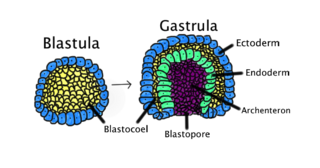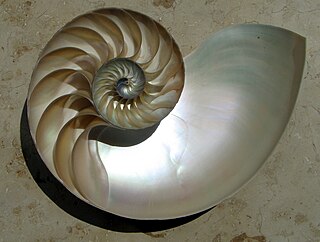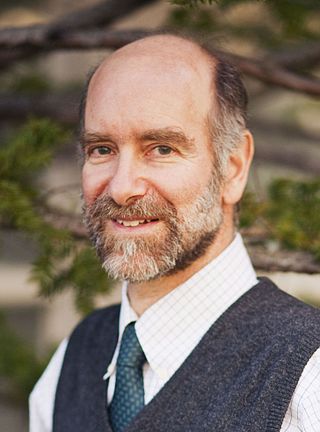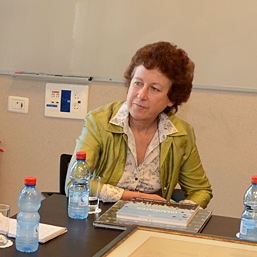
Calcium carbonate is a chemical compound with the chemical formula CaCO3. It is a common substance found in rocks as the minerals calcite and aragonite, most notably in chalk and limestone, eggshells, gastropod shells, shellfish skeletons and pearls. Materials containing much calcium carbonate or resembling it are described as calcareous. Calcium carbonate is the active ingredient in agricultural lime and is produced when calcium ions in hard water react with carbonate ions to form limescale. It has medical use as a calcium supplement or as an antacid, but excessive consumption can be hazardous and cause hypercalcemia and digestive issues.

Aragonite is a carbonate mineral and one of the three most common naturally occurring crystal forms of calcium carbonate, the others being calcite and vaterite. It is formed by biological and physical processes, including precipitation from marine and freshwater environments.

Gastrulation is the stage in the early embryonic development of most animals, during which the blastula, or in mammals the blastocyst, is reorganized into a two-layered or three-layered embryo known as the gastrula. Before gastrulation, the embryo is a continuous epithelial sheet of cells; by the end of gastrulation, the embryo has begun differentiation to establish distinct cell lineages, set up the basic axes of the body, and internalized one or more cell types including the prospective gut.

Nacre, also known as mother of pearl, is an organic–inorganic composite material produced by some molluscs as an inner shell layer. It is also the material of which pearls are composed. It is strong, resilient, and iridescent.

Biomineralization, also written biomineralisation, is the process by which living organisms produce minerals, often resulting in hardened or stiffened mineralized tissues. It is an extremely widespread phenomenon: all six taxonomic kingdoms contain members that are able to form minerals, and over 60 different minerals have been identified in organisms. Examples include silicates in algae and diatoms, carbonates in invertebrates, and calcium phosphates and carbonates in vertebrates. These minerals often form structural features such as sea shells and the bone in mammals and birds.
Gilbert Stork was an organic chemist. For a quarter of a century he was the Eugene Higgins Professor of Chemistry Emeritus at Columbia University. He is known for making significant contributions to the total synthesis of natural products, including a lifelong fascination with the synthesis of quinine. In so doing he also made a number of contributions to mechanistic understanding of reactions, and performed pioneering work on enamine chemistry, leading to development of the Stork enamine alkylation. It is believed he was responsible for the first planned stereocontrolled synthesis as well as the first natural product to be synthesised with high stereoselectivity.

Dolichyl pyrophosphate Man9GlcNAc2 alpha-1,3-glucosyltransferase is an enzyme that in humans is encoded by the ALG6 gene.

The molluscshell is typically a calcareous exoskeleton which encloses, supports and protects the soft parts of an animal in the phylum Mollusca, which includes snails, clams, tusk shells, and several other classes. Not all shelled molluscs live in the sea; many live on the land and in freshwater.

Mineralized tissues are biological tissues that incorporate minerals into soft matrices. Typically these tissues form a protective shield or structural support. Bone, mollusc shells, deep sea sponge Euplectella species, radiolarians, diatoms, antler bone, tendon, cartilage, tooth enamel and dentin are some examples of mineralized tissues.
Laura Lee Kiessling is an American chemist and the Novartis Professor of Chemistry at the Massachusetts Institute of Technology. Kiessling's research focuses on elucidating and exploiting interactions on the cell surface, especially those mediated by proteins binding to carbohydrates. Multivalent protein-carbohydrate interactions play roles in cell-cell recognition and signal transduction. Understanding and manipulating these interactions provides tools to study biological processes and design therapeutic treatments. Kiessling's interdisciplinary research combines organic synthesis, polymer chemistry, structural biology, and molecular and cell biology.

A mesocrystal is a material structure composed of numerous small crystals of similar size and shape, which are arranged in a regular periodic pattern. It is a form of oriented aggregation, where the small crystals have parallel crystallographic alignment but are spatially separated.

Amorphous calcium carbonate (ACC) is the amorphous and least stable polymorph of calcium carbonate. ACC is extremely unstable under normal conditions and is found naturally in taxa as wide-ranging as sea urchins, corals, mollusks, and foraminifera. It is usually found as a monohydrate, holding the chemical formula CaCO3·H2O; however, it can also exist in a dehydrated state, CaCO3. ACC has been known to science for over 100 years when a non-diffraction pattern of calcium carbonate was discovered by Sturcke Herman, exhibiting its poorly-ordered nature.

Nicholas A. Kotov is the Irving Langmuir Distinguished Professor of Chemical Sciences and Engineering at the University of Michigan in Ann Arbor, MI, USA. Prof. Nicholas Kotov demonstrated that the ability to self-organize into complex structures is the unifying property of all inorganic nanostructures. He has developed a family of bioinspired composite materials with a wide spectrum of properties that were previously unattainable in classical materials. These composite biomimetic materials are exemplified by his nacre-like ultrastrong yet transparent composites, enamel-like, stiff yet vibration-isolating composites, and cartilage-like membranes with both high strength and ion conductance.

The Open Tree of Life is an online phylogenetic tree of life – a collaborative effort, funded by the National Science Foundation. The first draft, including 2.3 million species, was released in September 2015. The Interactive graph allows the user to zoom in to taxonomic classifications, phylogenetic trees, and information about a node. Clicking on a species will return its source and reference taxonomy.

Jonathan Alan Patz is an American academic who is a professor and John P. Holton Chair of Health and the Environment at the University of Wisconsin-Madison, where he serves as Director of the Global Health Institute. Patz also holds appointments in the Nelson Institute for Environmental Studies and the Department of Population Health Sciences at the UW-Madison. He serves on the executive committee of the Tyler Prize for Environmental Achievement and was elected in 2019 to the National Academy of Medicine.
Abigail L. S. Swann is an Associate Professor of Atmospheric Sciences and Ecology at the University of Washington. Her research group focuses on questions that examine the interactions between plants and climate.
Kai-Mei Fu is an American electrical engineer and physicist. They are an Associate Professor of Physics and Electrical Engineering at the University of Washington where they are the director of the Optical Spintronics and Sensing Lab.

Lia Addadi is a professor of structural biology at the Weizmann Institute of Science. She works on crystallisation in biology, including biomineralization, interactions with cells and crystallisation in cell membranes. She was elected a member of the National Academy of Sciences (NAS) in 2017 for “distinguished and continuing achievements in original research”, and the American Philosophical Society (2020).
Jessica Hullman is a computer scientist and the Ginni Rometty professor of Computer Science at Northwestern University. She is known for her research in Information visualization and Uncertainty quantification.
Ahna Renee Skop is an Native American American geneticist, artist, and a professor at the University of Wisconsin–Madison. She is known for her research on the mechanisms underlying asymmetric cell division, particularly the importance of the midbody in this process.














